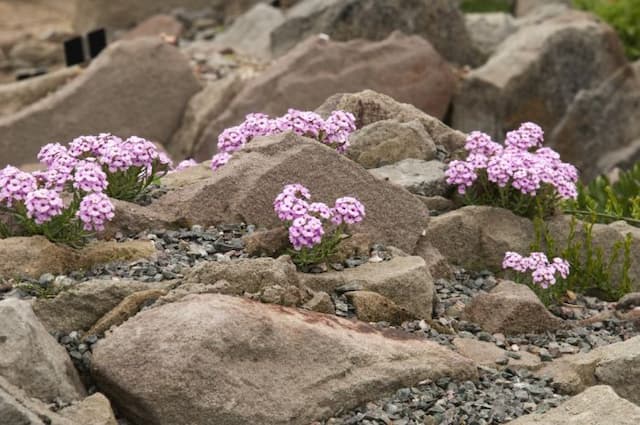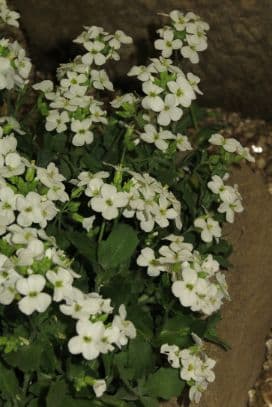Rock cress Aubrieta Axcent Light Blue = 'Abrz0002' (PBR) (Axcent Series)
![aubrieta [Axcent Light Blue]](/_next/image?url=https%3A%2F%2Fplants-admin.emdemapps.com%2Fimages%2Fplants%2F%2Fimages%2F604b5e7128866.png&w=3840&q=75)
ABOUT
Aubrieta Axcent Light Blue, part of the Axcent Series, is a charming perennial known for its vibrant display in the garden. As the name suggests, the plant is adorned with light blue flowers which add a soft, pastel hue to the landscape. The flowers typically have a small to medium size with a delicate and simple form, often appearing in masses to create a carpet of color. The leaves of this plant are small, and they typically exhibit a green to grey-green color, contributing to a dense, ground-hugging mat. This perennial is often used as a ground cover due to its low-growing habit and ability to spread, cloaking the soil in a blanket of foliage and blossoms. The foliage may also showcase a slight texture, with edges that could be either smooth or slightly serrated, giving it a full-bodied appearance. When in bloom, the Aubrieta Axcent Light Blue creates a harmonious blend with its surrounding, whether planted along borders, tumbling over rocks, or cascading down walls. Overall, it presents a picturesque and serene vista during its flowering season.
About this plant
 Names
NamesFamily
Brassicaceae
Synonyms
Axcent Light Blue Rock Cress, Axcent Light Blue Aubrieta
Common names
Aubrieta Axcent Light Blue = 'Abrz0002' (PBR) (Axcent Series).
 Toxicity
ToxicityTo humans
The plant commonly known as Rock Cress is generally considered non-toxic to humans. Ingesting parts of the plant is unlikely to cause serious harm, but it's always advisable to avoid eating ornamental plants due to potential adverse reactions or the presence of garden chemicals.
To pets
Rock Cress is also generally considered non-toxic to pets. While ingestion of this plant shouldn't cause serious illness, it can potentially cause mild gastrointestinal upset if consumed in large quantities, as with many plants that are not part of an animal’s normal diet. It’s still best to prevent pets from eating ornamental plants as a precaution.
 Characteristics
CharacteristicsLife cycle
Perennials
Foliage type
Evergreen
Color of leaves
Green
Flower color
Light Blue
Height
6 inches (15 cm)
Spread
12 inches (30 cm)
Plant type
Herb
Hardiness zones
4
Native area
Europe
Benefits
 General Benefits
General Benefits- Low Maintenance: Requires minimal care once established, making it ideal for busy gardeners or those seeking low-effort landscaping.
- Drought Tolerant: Can survive with limited water, making it suitable for xeriscaping or drought-prone regions.
- Ground Cover: Forms dense mats that can help prevent soil erosion and suppress weed growth.
- Attracts Pollinators: Flowers are attractive to bees and butterflies, promoting biodiversity.
- Seasonal Interest: Offers bright blooms in spring, adding vibrant color to gardens when many other plants are not yet in flower.
- Rock Gardens and Walls: Well-suited for growing in rocky conditions, making it ideal for rock gardens and wall crevices.
- Containers and Hanging Baskets: Its cascading habit makes it attractive in containers and hanging baskets, providing versatility in garden design.
- Edging Plant: Compact growth habit makes it excellent for borders and edging in garden beds.
- Cold Hardy: Capable of withstanding colder temperatures, appropriate for cooler climates.
 Medical Properties
Medical PropertiesThis plant is not used for medical purposes.
 Air-purifying Qualities
Air-purifying QualitiesThis plant is not specifically known for air purifying qualities.
 Other Uses
Other Uses- Aubrieta can act as a natural dye source, with different parts of the plant yielding varying shades of blue and green when used in traditional fabric-dyeing processes.
- The dense foliage of Aubrieta can be used as a natural carpeting on slopes or hills in landscapes, helping to stabilize the soil and prevent erosion.
- When dried, the leaves of Aubrieta can impart subtle hues and scents when used in potpourri mixes, providing a decorative and fragrant addition to homes.
- Aubrieta is often used as a living mulch to keep the ground cool and moist, reducing the need for watering and weeding in the garden.
- Due to its cascading growth, Aubrieta can be an innovative covering for unsightly garden structures like walls or fences, turning them into vertical gardens.
- Gardeners may implement Aubrieta to outcompete weeds naturally due to its low-growing and mat-forming characteristics.
- When strategically planted, Aubrieta can guide the flow of runoff in gardens following rain, directing water to less resilient plants that need more moisture.
- The plant can be used as an indicator for pH levels of soil; healthy Aubrieta growth often signifies a more alkaline soil environment.
- Aubrieta can be used in sensory gardens, as it provides a visual and tactile experience with its soft-to-touch leaves and vibrant blooms.
Interesting Facts
 Feng Shui
Feng ShuiRock cress is not used in Feng Shui practice.
 Zodiac Sign Compitability
Zodiac Sign CompitabilityRock cress is not used in astrology practice.
 Plant Symbolism
Plant Symbolism- Perseverance: Aubrieta, also known as Rock Cress, often grows in rocky, challenging environments, symbolizing the ability to thrive in tough conditions and representing determination and resilience.
- Beauty: The Light Blue flowers of Rock Cress offer a delicate beauty in the early spring, symbolizing the appreciation of natural beauty and the joy it can bring.
- Grounding: As a ground-cover plant, Rock Cress symbolizes stability and being grounded, reminding one to stay connected with the earth and their environment.
- Overcoming adversity: The robust nature of Rock Cress and its capacity to flourish in rugged terrains can symbolize the ability to overcome difficulties and endure adversity with grace.
 Water
WaterFor the false rock cress, adjust watering to maintain a consistent level of moisture without waterlogging the soil. Generally, this means watering it once or twice a week, depending on weather conditions and soil drainage. In hot, dry periods, watering frequency may need to be increased. A good method is to provide a deep watering that moistens the entire root zone, which equates to about one gallon of water per square foot, every week during the growing season. Cut back on watering in the fall as the plant prepares for dormancy, and over winter, water only sparingly, if at all, to prevent root rot.
 Light
LightFalse rock cress thrives best in full sunlight, receiving at least six hours of direct sunlight daily. It can tolerate some partial shade, but the blooms may not be as prolific. The ideal spot for planting false rock cress would be in a south-facing garden location that provides ample sunlight throughout the day.
 Temperature
TemperatureFalse rock cress is tolerant of a wide range of temperatures and can survive minimum temperatures down to about -20 degrees Fahrenheit, making it suitable for many temperate climates. Its ideal growing conditions are in areas where the temperature averages between 60 and 75 degrees Fahrenheit. Excessive heat can stress the plant, so providing some afternoon shade in regions with hot summers can be beneficial.
 Pruning
PruningPruning false rock cress helps to maintain its shape and promote denser growth. Prune lightly after flowering to remove spent blooms and encourage a second flush of flowers. Annually, after the last frost in spring, cut back the foliage by about half to rejuvenate the plant. The best time for major pruning is early spring or immediately after the plant finishes its main flowering period.
 Cleaning
CleaningAs needed
 Soil
SoilThe best soil mix for Rock Cress (Aubrieta) is a well-draining mix with compost, loam, and gritty material like perlite or sand. A slightly alkaline to neutral pH of 6.5 to 7.5 is ideal for Rock Cress.
 Repotting
RepottingRock Cress, typically growing as a ground cover, rarely requires repotting. If grown in containers, repot every 2-3 years or as the plant outgrows its pot.
 Humidity & Misting
Humidity & MistingRock Cress prefers outdoor conditions with low to moderate ambient humidity. It is tolerant of a wide range of humidity levels as long as there is good air circulation.
 Suitable locations
Suitable locationsIndoor
Ensure full sun, limited watering, and well-draining soil.
Outdoor
Plant in full sun, light soil, water sparingly; tolerates dryness.
Hardiness zone
4-9 USDA
 Life cycle
Life cycleThe plant Aubrieta Axcent Light Blue, commonly known as Purple Rock Cress, begins its life as a seed that germinates in early spring, requiring well-drained soil and some light for optimal growth. After germination, the plant enters the vegetative stage where it develops a low, mat-forming habit with small, oval-shaped, green leaves. As it matures, typically within a few weeks, it enters the flowering stage, producing a profusion of light blue flowers that attract pollinators and provide a vibrant display in rock gardens and along garden borders. After flowering, which usually occurs from mid to late spring, the plant sets seed, completing its annual reproductive cycle, and the seeds are dispersed to give rise to new individuals. Post-flowering, Aubrieta Axcent Light Blue enters a period of dormancy during the colder months, with foliage that often remains evergreen in milder climates. The plant can live for several years, re-sprouting from the base and continuing its life cycle, and can also be propagated through softwood cuttings or division in the spring or autumn.
 Propogation
PropogationPropogation time
Early spring
The most popular method of propagating the Aubrieta Axcent Light Blue, commonly known as the Rock Cress, is through cuttings. This process typically occurs in late spring or early summer when the plant's growth is most vigorous. To propagate through cuttings, select a healthy stem with several leaves and cut a 3- to 4-inch segment using a sharp, sterilized pruner. Remove the lower leaves to expose a clear section of stem and then dip the cut end into a rooting hormone powder. Insert the cutting into a well-draining soil mix, water gently, and cover with a plastic bag to retain humidity. Keep the cutting in indirect light, and ensure the soil remains moist but not waterlogged. Roots usually develop within a few weeks, after which the new plants can be transplanted to individual pots or outdoor locations.









